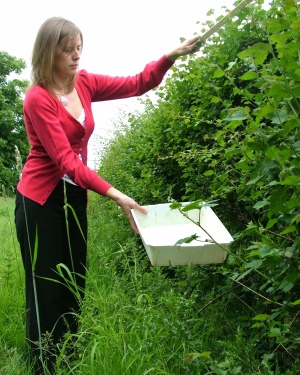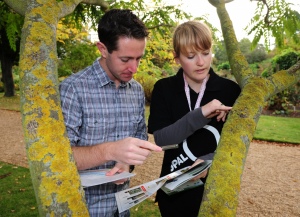

A citizen science study has revealed that being next to just one hard surface reduces the diversity of plants and animals in hedgerows.
The UK-wide study asked volunteers to record details about hedges both in rural settings, like farmland, and urban settings, like gardens. Nearly 3,000 hedgerows were investigated by members of the public.
Rural and urban hedges were found to have different plants, insect and spider communities, but both were affected by the presence of a road or path nearby.

Image: OPAL
Rural hedges were more commonly made up of plants like blackthorn, bramble and dog rose, whereas urban hedges were more likely to be beech, holly, laurel and privet. Rural hedges also had more blowflies, caterpillars, harvestmen compared to urban hedges, which harboured more ants, earwigs and shield bugs.
In urban hedges with one adjacent hard surface, the food available for wildlife, such as berries, was significantly reduced. Even in rural hedges, one adjacent hard surface reduced the diversity of invertebrates.
The findings suggest urban planners should take into account the surfaces surrounding hedges in order to make them better refuges for wildlife.
Water everywhere
The results were released earlier this month as a part of a review of the Open Air Laboratories (OPAL) citizen science project, hosted by Imperial College London. A total of five papers were published in the open-access journal BMC Ecology.
The results of a second citizen science study of water quality in more than 3,000 British lakes and ponds was also published. It asked participants to record small animal types and numbers as a measure of water quality, and revealed that 10 per cent of lakes and ponds surveyed were ‘poor’ quality while 27 per cent were in the highest water quality band.
While the OPAL team acknowledged there may be some inconsistency in how the public reports these factors, they used independent scientists to monitor and control the quality of a number of lakes and ponds to verify the results.
Useful research

Image: OPAL
OPAL has become one of the largest citizen science programmes in the UK. It involves studies on both local and national scales in an effort to answer scientific questions and monitor environmental factors, such as species distribution. The surveys tackle environmental change issues from land use modification to invasive species.
Since 2007, this has led to some interesting findings:
- Environmental health monitoring: Results from the OPAL Air Survey showed that lichens can be used as ‘bio-indicators’ to monitor local levels of air pollution, and lead to the discovery that nitrogen-sensitive lichen communities were reduced close to roads.
- Evidence-led decision making: The OPAL Soil Survey demonstrated that a participatory approach can generate useful data for prioritising soil assessment and help to address concerns around soil protection policies.
- New methods to investigate the natural world: Academic papers on the Bugs Count and Tree Bumblebee surveys showed that citizen science approaches can complement traditional scientific approaches and gather data over wide timescales and spaces, as well as allowing access to areas otherwise difficult to study, such as private property.
Real meaning
Senior Programme Coordinator for OPAL Dr Poppy Lakeman Fraser from the Centre for Environmental Policy at Imperial said: “As we approach our ten-year anniversary, we are incredibly proud of what our community of citizen scientists and practitioners - almost one million of them - have achieved. We hope to be able to continue to support co-produced science for generations to come.”
The OPAL review papers not only looked at results, but also how people engage with citizen science projects and how they can usefully contribute to research.
“We find that people derive real meaning from being a part of the scientific process,” said Dr Lakeman Fraser.
“Well-designed projects can balance the two main aims of citizen science, namely obtaining data that is useful to science and providing opportunities for people to learn about, gain skills and contribute to society.”
-
Read a blog discussing citizen science and the findings of the recent publications
Read all the recent publications for free
Article text (excluding photos or graphics) available under an Attribution-NonCommercial-ShareAlike Creative Commons license.
Photos and graphics subject to third party copyright used with permission or © Imperial College London.
Reporter
Hayley Dunning
Communications Division

Contact details
Tel: +44 (0)20 7594 2412
Email: h.dunning@imperial.ac.uk
Show all stories by this author




Leave a comment
Your comment may be published, displaying your name as you provide it, unless you request otherwise. Your contact details will never be published.